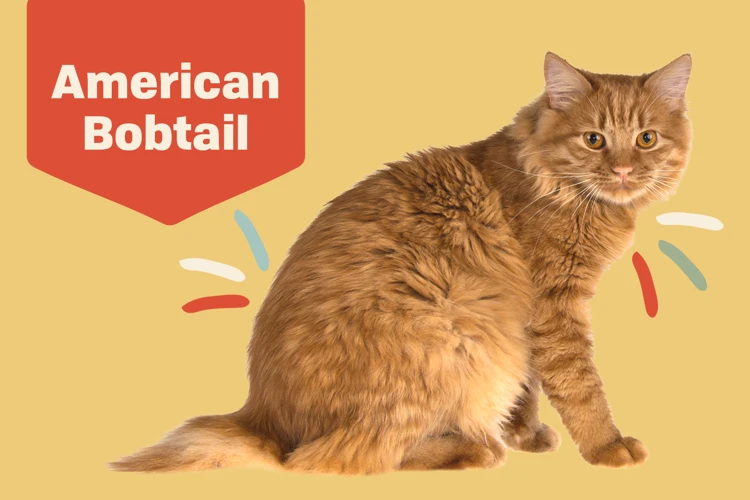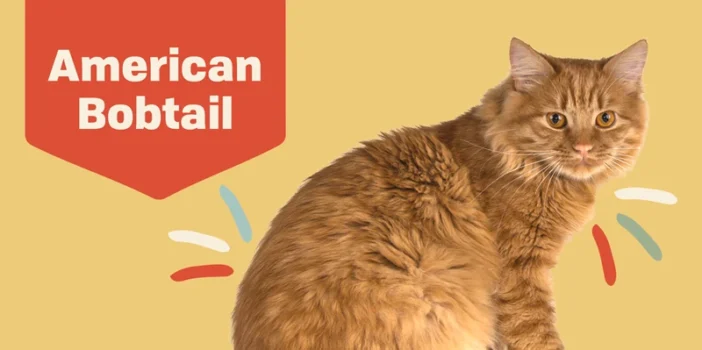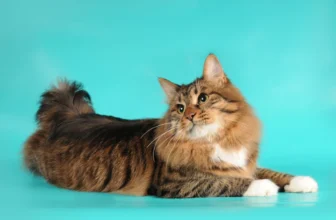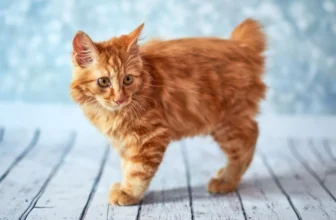When it comes to our feline friends, their health and well-being are always a top priority. This rings true for the American Bobtail cat, a unique breed known for its distinctive short tail and affectionate personality. However, just like any other cat breed, American Bobtails are susceptible to certain health issues that owners should be aware of. In this article, we’ll explore the top 5 health issues that American Bobtail cats might encounter, including their symptoms, prevention, and treatment options. As a responsible owner, it’s essential to understand these potential health concerns so that you can help your furry companion thrive for years to come.
1. Obesity

One of the most common health issues that American Bobtail cats might encounter is obesity. Obesity is a serious medical condition that can lead to many other health problems such as diabetes, heart disease, and joint problems. As with humans, obesity in cats happens when there is an imbalance between the amount of calories consumed and the amount of calories burned. Indoor cats are especially prone to obesity because they have limited physical activity. It is crucial to detect and prevent obesity in American Bobtails before it becomes a serious health concern. In the next sections, we will cover the symptoms and prevention methods of obesity in American Bobtails. To prevent obesity, it is essential to give our furry companions the proper nutrition they need. If you want to know more about a balanced diet for American Bobtail cats, you may find helpful information in this article.
Symptoms of obesity in American Bobtail Cats
Obesity is a common health issue in American Bobtail cats that can significantly affect their quality of life. Owners should be aware of the signs and symptoms of obesity in their cats.
The symptoms of obesity in American Bobtail Cats include:
| Symptom | Description |
|---|---|
| Excessive weight gain | A noticeable increase in weight, with the cat becoming visibly rounder and chunkier. There may be rolls of fat around the belly and limbs. |
| Lethargy or decreased activity | The cat may become less active or play less, preferring to sleep or lounge around the house. They may tire more quickly, be hesitant to jump, or avoid running or chasing games. |
| Difficulty grooming | Obese cats may find it difficult to reach certain parts of their body and may stop grooming themselves correctly. This can lead to matted fur, dandruff or flakiness, and even skin infections. |
| Shortness of breath or panting | Obese cats may experience breathing difficulties or panting after minimal physical activity, such as climbing stairs or playing with their toys. |
| Increased risk of other health issues | Obese cats are more likely to develop other health issues, such as arthritis, diabetes, and heart disease. |
It is essential for cat owners to take steps to prevent obesity and help their cats lose weight if necessary. A balanced diet, regular physical exercise, and closely monitoring the cat’s weight are all effective strategies. To understand the nutritional needs of American Bobtail cats, refer to Understanding Nutritional Needs of American Bobtail Kittens, and for information on cat food labels, refer to Cat Food Labels and Nutrition for American Bobtail Cats. Additionally, probiotics can improve digestion and prevent weight gain, read more about it in Probiotics and American Bobtail Digestion. By taking these steps, cat owners can ensure their American Bobtail cats remain healthy, happy, and at a healthy weight.
How to prevent and treat obesity in American Bobtail Cats
To prevent and treat obesity in American Bobtail cats, there are several steps that pet owners can take.
1. Control their diet: Limiting the amount of food they consume each day is the first step in preventing obesity in cats. Owners should aim to feed their American Bobtail cats high-quality, low-calorie foods that are specifically formulated for felines.
2. Provide ample exercise: Regular exercise is essential to maintain a healthy weight in American Bobtail cats. Owners should encourage their cats to play and explore, offering plenty of toys and opportunities for physical activity.
3. Monitor Food intake: Pet owners should monitor the portion sizes and calorie intake of their American Bobtail cats to ensure they’re not overeating. Additionally, limiting treats and table scraps will help to maintain a healthy weight.
4. Schedule regular vet visits: Annual check-ups with a veterinarian can help to identify early signs of obesity and other health issues.
5. Treat existing obesity: If the American Bobtail cat is already overweight or obese, the owner should consult with a veterinarian to create an appropriate weight-loss plan, which may include a special diet and exercise routine.
Maintaining a healthy weight through proper diet and exercise is essential to the long-term health and wellness of American Bobtail cats. By following these preventative measures and seeking professional guidance, pet owners can help to prevent and treat obesity in their feline companions.
2. Hypertrophic cardiomyopathy (HCM)

Hypertrophic cardiomyopathy, commonly known as HCM, is a serious health issue that affects American Bobtail Cats. This condition is characterized by the thickening of the heart muscles, which can lead to various heart-related problems. HCM is the most common heart disease found in cats and can affect cats of any age, gender, or breed. It is essential for cat owners to be aware of the symptoms, causes, and treatment options for HCM to ensure their cats’ optimal health and prevent potential life-threatening consequences. Let’s dive deeper into HCM and its impact on American Bobtail cats.
Symptoms of HCM in American Bobtail Cats
Hypertrophic cardiomyopathy (HCM) is a common heart disease in American Bobtail cats. This disease is usually inherited and affects the heart muscles, causing the walls of the heart to grow thicker, making it difficult for the heart to function properly.
Here are some signs and symptoms that your American Bobtail cat may be experiencing HCM:
- Heart murmur: This is one of the most common signs of HCM in American Bobtail cats. Your vet may detect an abnormal heart sound using a stethoscope.
- Coughing: Your cat may experience coughing, which is caused by fluid buildup in their lungs due to the heart’s inability to pump blood effectively.
- Breathing difficulties: Your cat may experience breathing difficulties, which is a symptom of fluid accumulation in the lungs.
- Reduced appetite: Your cat may lose their appetite, which is caused by the discomfort and pain associated with HCM.
- Restlessness: Your cat may be restless due to heart palpitations and discomfort.
- Lethargy: Your cat may appear to be less active and tired due to a weakened heart.
If you notice any of these symptoms in your American Bobtail cat, it is important to take them to the vet immediately. Early detection and treatment of HCM can help manage the disease and improve the quality of life for your furry friend.
How to prevent and treat HCM in American Bobtail Cats
Hypertrophic cardiomyopathy (HCM) is a heart condition that affects the muscular walls of the heart. While there is no known cure for HCM, there are steps you can take to prevent and treat it in your American Bobtail cat.
Prevention: One way to prevent HCM in your American Bobtail is to ensure proper nutrition. Feed your cat a diet that is high in protein and low in carbohydrates to promote heart health. Additionally, make sure your cat maintains a healthy weight to reduce the risk of obesity, which can contribute to HCM.
Another way to prevent HCM is to keep your cat active. Encourage exercise through playtime and provide opportunities for your cat to climb and explore.
Finally, it is important to schedule regular check-ups with your veterinarian to monitor your cat’s heart health and catch any potential issues early on.
Treatment: While there is no cure for HCM, there are treatments available to manage the condition and improve your cat’s quality of life.
One option is medication, such as beta-blockers and calcium channel blockers, which can help to control the heart’s rhythm and reduce symptoms.
In more severe cases, surgery may be recommended to remove a portion of the thickened heart muscle, improving blood flow and reducing strain on the heart.
It is important to note that treatment options will vary depending on your cat’s specific needs and the severity of the condition. Consult with your veterinarian to determine the best course of treatment for your American Bobtail.
| Prevention | Treatment |
|---|---|
| Feed a diet high in protein and low in carbohydrates Ensure your cat maintains a healthy weight Encourage exercise and playtime Schedule regular check-ups with your veterinarian |
Medication (beta-blockers and calcium channel blockers) Surgery to remove a portion of the thickened heart muscle |
3. Periodontal diseases

As you take care of your American Bobtail cat, it’s essential not to overlook their dental hygiene. Periodontal diseases are a significant concern for felines, including the American Bobtail breed. These diseases can cause pain, discomfort, and even lead to tooth loss if not addressed promptly. It’s crucial to know the symptoms and treatment options so you can keep your furry friend healthy and happy. Let’s dive into the details.
Symptoms of periodontal diseases in American Bobtail Cats
Periodontal diseases are a common health issue in American Bobtail Cats. If your furry friend is suffering from this condition, you may notice some of the following symptoms:
- Bad breath: One of the most common signs of periodontal disease is foul-smelling breath. If your cat’s breath smells unusually bad, it could be an indication of dental problems.
- Tartar buildup: You may notice yellow or brown buildup on your cat’s teeth or along the gumline. This buildup can be a result of plaque buildup that has hardened over time.
- Bleeding or inflamed gums: If you notice that your cat’s gums are swollen, irritated, or bleeding, it could be a sign of periodontal disease. This condition can cause gums to separate from the teeth, forming pockets that can become infected.
- Tooth pain: Cats with periodontal disease may experience pain while eating or may paw at their mouth or face. This is because the teeth and gums may be sensitive or painful.
- Loss of teeth: In severe cases of periodontal disease, cats may lose teeth. This happens when the roots of the teeth become so infected that the tooth must be extracted.
If you notice any of these symptoms in your American Bobtail Cat, it’s important to take them to the veterinarian as soon as possible. Early treatment can help prevent further damage and improve your cat’s overall oral health.
How to prevent and treat periodontal diseases in American Bobtail Cats
Preventing periodontal diseases in American Bobtail Cats can be achieved by taking some simple steps. These steps include:
1. Regular dental checks: Regular dental checks are essential for maintaining good oral hygiene in cats. A veterinary dentist should perform these checks to ensure that there are no underlying dental issues that could lead to more severe health problems.
2. Brushing your cat’s teeth: Brushing your cat’s teeth regularly can help prevent periodontal diseases. Use a special toothbrush designed for cats and toothpaste that is safe for them to ingest.
3. Feeding your cat a healthy diet: Feeding your cat a balanced diet that contains all the necessary nutrients is essential for maintaining good oral health. A balanced diet helps prevent oral problems and keeps your cat’s teeth healthy and strong.
4. Providing dental toys and treats: Providing dental toys and treats can help prevent the buildup of plaque and tartar on your cat’s teeth. These toys and treats are specifically designed to promote good oral health in cats.
If your American Bobtail Cat already has periodontal disease, treating the condition requires immediate attention. Some possible treatments for periodontal diseases in American Bobtail Cats are:
| Treatment | Description |
|---|---|
| Professional Dental Cleaning | A professional dental cleaning performed by a veterinary dentist can remove plaque and tartar buildup and prevent further damage to teeth and gums. |
| Antibiotics | Antibiotics can be prescribed to help control bacterial infections that cause periodontal diseases in cats. |
| Extraction of Severe Teeth | In severe cases, teeth that cannot be saved may need to be extracted. This is usually done under general anesthesia. |
| Pain Management | Painkillers can be prescribed to manage pain and discomfort caused by periodontal diseases. |
It is important to note that prevention is always better than cure. Taking the necessary steps to prevent periodontal diseases in American Bobtail Cats is crucial for maintaining good oral health and overall well-being.
4. Feline Lower Urinary Tract Disease (FLUTD)

Feline Lower Urinary Tract Disease (FLUTD) is a common and debilitating health issue that can afflict American Bobtail cats. This condition encompasses a range of disorders within the urinary tract that can affect the bladder, urethra, and/or kidneys, resulting in a variety of distressing symptoms. Cats suffering from FLUTD may experience discomfort and pain when trying to urinate, and may even become unable to urinate at all. Given the serious nature of FLUTD, it’s crucial for Bobtail owners to be aware of its symptoms, causes, and treatment options. Let’s take a closer look.
Symptoms of FLUTD in American Bobtail Cats
Feline Lower Urinary Tract Disease (FLUTD) is a common health issue in American Bobtail cats, and it can lead to serious problems if left untreated. Some of the symptoms of FLUTD in American Bobtail cats include:
- Frequent urination: If you notice that your American Bobtail is urinating more frequently than usual or spending a longer time in the litter box than usual, it could be a sign of FLUTD.
- Painful urination: If your cat cries out in pain while urinating, it could indicate that they have FLUTD.
- Blood in the urine: Blood in the urine is a common sign of FLUTD in American Bobtail cats. If you notice blood, take your cat to the vet immediately.
- Urinating outside the litter box: If your American Bobtail suddenly starts urinating outside of the litter box, it could indicate that they are experiencing discomfort while urinating, which is a sign of FLUTD.
- Excessive licking of genital area: If your cat is constantly grooming their genital area or seems to be in discomfort while doing so, it could be a sign of FLUTD.
It is important to note that these symptoms may also be present in other health issues, so if you notice any of these signs, you should take your American Bobtail to the vet immediately for a proper diagnosis.
How to prevent and treat FLUTD in American Bobtail Cats
Feline Lower Urinary Tract Disease (FLUTD) is a common health issue that American Bobtail Cats might encounter. It can be prevented and treated by following some simple steps. Here are some ways to prevent and treat FLUTD in American Bobtail Cats:
1. Provide fresh water: Make sure your American Bobtail Cat has access to plenty of fresh water. Staying hydrated helps prevent FLUTD.
2. Feed a balanced diet: A balanced diet is crucial for maintaining the overall health of your cat, including the urinary tract. Include wet food in their diet as it contains moisture which helps in flushing out toxins through urine.
3. Keep litter boxes clean: Cats are naturally clean animals and like their litter boxes to be clean as well. Make sure to scoop the litter box on a regular basis, and clean it with soap and water once a week.
4. Don’t change the litter brand suddenly: If you need to change the litter brand, do it gradually. Sudden changes can cause stress and even FLUTD.
5. Treat any underlying medical conditions: If your cat has any medical conditions such as diabetes or arthritis, treating them promptly can help prevent FLUTD.
6. Watch for symptoms: Watch for any symptoms of FLUTD such as straining to urinate, blood in urine, or excessive grooming of the genital area. If any symptoms appear, take your cat to the vet immediately.
7. Medications: In severe cases, medication may be needed to help relieve the symptoms of FLUTD. Make sure to follow the veterinarian’s instructions carefully.
By following these preventive measures, you can help reduce the risk of FLUTD in your American Bobtail Cat. If your cat does develop FLUTD, taking prompt action can help ensure a quick recovery.
5. Hip dysplasia
Hip dysplasia is a common health issue that can affect American Bobtail cats. This condition occurs when the hip joint does not develop properly, causing pain and discomfort for the cat. It can be a perplexing and frustrating issue for cat owners to deal with, as they may not be sure how to prevent or treat it. In this section of the article, we’ll explore the symptoms of hip dysplasia and offer suggestions on how to manage this condition in American Bobtail cats.
Symptoms of hip dysplasia in American Bobtail Cats
Hip dysplasia is a condition that affects the hip joint in cats. It is a genetic disorder that results in malformed hip joints and is prevalent in certain breeds, including the American Bobtail cats. The symptoms of hip dysplasia in American Bobtail cats include:
- Limping: If your American Bobtail cat has hip dysplasia, they may have difficulty walking and might develop a limp.
- Decreased mobility: Cats with hip dysplasia may have trouble jumping and moving around because of the pain and stiffness in their hip joints.
- Pain: Hip dysplasia can be a painful condition for cats. If your American Bobtail cat is in pain, they may vocalize more than usual, become agitated or restless, or even become aggressive.
- Reduced activity: Your American Bobtail cat may be less active than normal if they have hip dysplasia. They may lay around more or sleep more than usual, and may not want to participate in playtime or other physical activities.
- Loss of muscle: If your cat has hip dysplasia, they may lose muscle mass in their hind legs as they become weaker due to the pain and lack of mobility.
It is important to note that these symptoms can be indicative of other conditions as well, so if you suspect your American Bobtail cat may be suffering from hip dysplasia or any other health issue, it is important to take them to a veterinarian for a proper diagnosis and treatment plan.
How to prevent and treat hip dysplasia in American Bobtail Cats
Hip dysplasia is a serious health issue that can affect American Bobtail Cats. It is a genetic condition where the hip joint does not develop properly, leading to arthritis and pain. If you have an American Bobtail Cat, it is important to take steps to prevent and treat hip dysplasia. Here are some tips to help keep your pet healthy:
Prevention:
- Choose a reputable breeder who tests their cats for hip dysplasia.
- Keep your American Bobtail Cat at a healthy weight to reduce stress on the hip joint.
- Provide regular exercise to ensure strong muscles and support for joint health.
- Avoid activities that are too strenuous for your cat’s joints, such as jumping from high surfaces.
Treatment:
- If your American Bobtail Cat is diagnosed with hip dysplasia, your vet may recommend pain medication or anti-inflammatory drugs to manage symptoms.
- In some cases, surgery may be necessary to correct the condition. Your vet can discuss the options available and recommend the best course of treatment for your cat.
- Physiotherapy can help with muscle strengthening and joint mobility. This may include exercises, massage or hydrotherapy.
- Provide your American Bobtail Cat with a comfortable bed or mattress to rest their joints and reduce impact on the hip.
By taking steps to prevent and treat hip dysplasia, you can help ensure your American Bobtail Cat leads a happy and healthy life. If you notice any symptoms of hip dysplasia, such as stiffness or difficulty walking, seek the advice of your vet as soon as possible. With proper care, your American Bobtail Cat can live a comfortable and active life.
Conclusion
In conclusion, it is essential to take care of the health of American Bobtail cats in order to ensure they live a long and healthy life. Obesity, hypertrophic cardiomyopathy, periodontal diseases, feline lower urinary tract disease, and hip dysplasia are some of the common health issues that American Bobtail cats might encounter.
Prevention is key in maintaining the health of our feline friends. Encouraging exercise and providing a balanced diet can help prevent obesity. Regular veterinary check-ups can help detect and prevent hypertrophic cardiomyopathy and periodontal diseases. Staying hydrated and providing a low-stress environment can help prevent FLUTD.
Early detection and treatment are also important in managing these health issues.
If you notice any symptoms such as lethargy, loss of appetite, or difficulty in movement, it is important to consult a veterinarian immediately.
By being proactive in managing their health, we can ensure that our American Bobtail cats lead happy and healthy lives.
Frequently Asked Questions
1. Can American Bobtail Cats get diabetes?
Yes, American Bobtail Cats are at risk of developing diabetes due to weight issues or genetic predisposition.
2. Is HCM common in American Bobtail Cats?
Yes, HCM is a relatively common health issue in American Bobtail Cats, as well as other breeds.
3. How often should I take my American Bobtail Cat to the vet?
It is recommended that you take your American Bobtail Cat to the vet at least once a year for a check-up and vaccinations.
4. Can periodontal diseases lead to other health problems in American Bobtail Cats?
Yes, if left untreated, periodontal diseases can lead to serious health issues such as kidney disease or heart problems.
5. Can FLUTD be fatal for American Bobtail Cats?
If left untreated, FLUTD can potentially be fatal for American Bobtail Cats due to bladder blockages and urinary tract infections.
6. Are American Bobtail Cats prone to hip dysplasia?
While hip dysplasia is more commonly associated with dogs, American Bobtail Cats can also develop the condition if they have a genetic predisposition or if they are overweight.
7. Can overfeeding lead to obesity in American Bobtail Cats?
Yes, overfeeding can easily lead to obesity in American Bobtail Cats, as well as other health issues.
8. Can HCM be prevented in American Bobtail Cats?
While there is no guaranteed way to prevent HCM in American Bobtail Cats, regular heart checkups at the vet and a healthy diet can help minimize the risk.
9. Can FLUTD be painful for American Bobtail Cats?
Yes, FLUTD can be painful for American Bobtail Cats and can cause discomfort and distress.
10. Can exercise help prevent health issues in American Bobtail Cats?
Yes, regular exercise helps maintain a healthy weight and can prevent various health issues in American Bobtail Cats such as obesity and muscle weakness.







